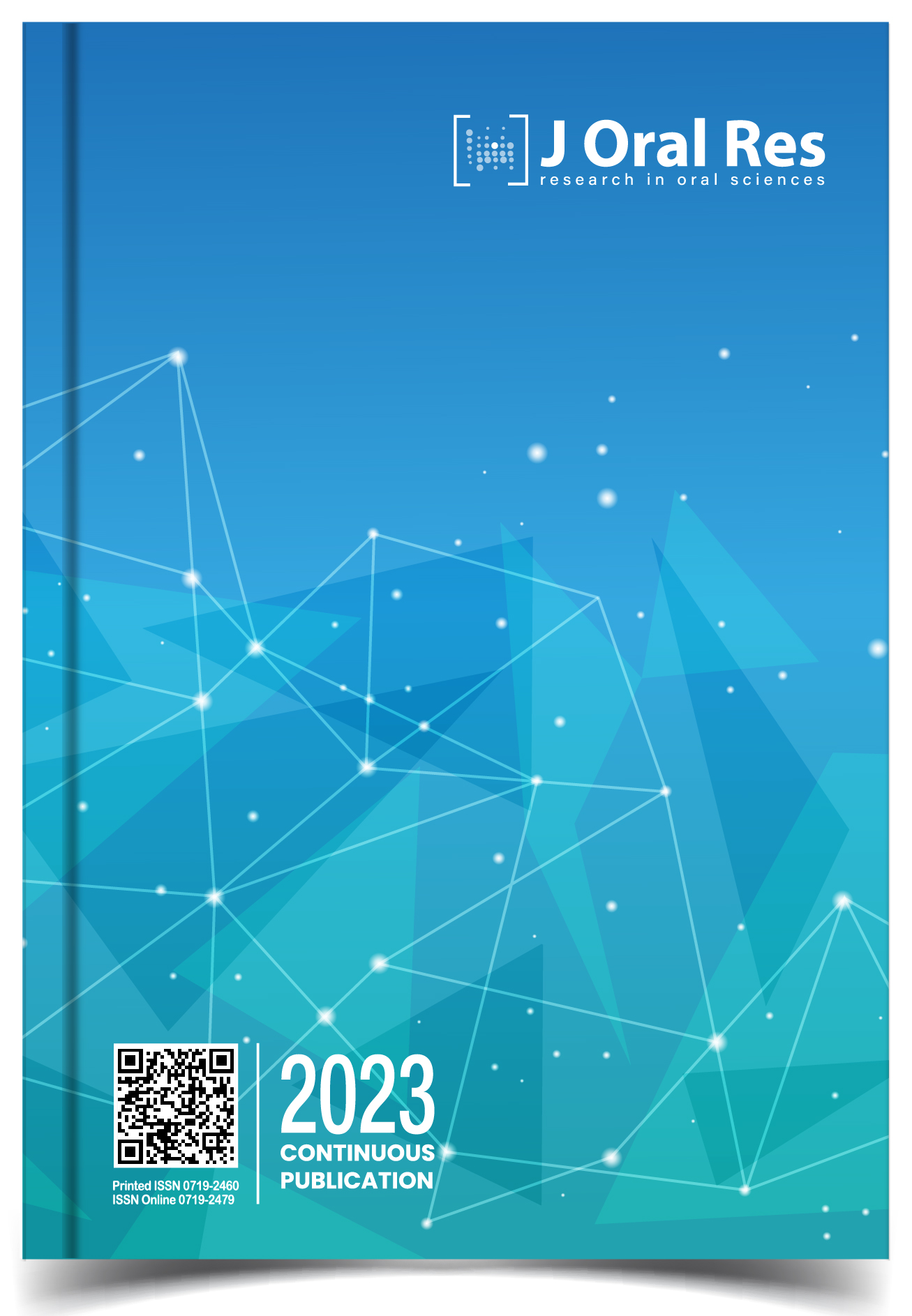In vitro comparison of marginal infiltration between a conventional resin and a bulk-fill resin, in the relocation of cervical margins technique.
Abstract
Introduction: Proximal lesions that exceed the cement enamel limit (ACE) under the gingival margin complicate impressions and the adhesive technique. Compare the magnitude of micro infiltration between conventional resin and bulk fill resin in the cervical margin relocation technique.
Materials and Methods: 48 samples of human teeth re-ceived two preparations: occluso-mesial (OM) and occluso-distal (OD) under LAC; first they received the cervical margin relocation technique (RMC) with bulk fill and conventional resin; then restored with semi-direct resinous inlays. Sample analysis: immersion in 50% colloidal silver nitrate solution, 24 hours, 37°C and cut mesiodistally. Observed under a stereoscopic magnifying glass to assess dye penetration and digitally photographed, analyzed with “Image J” software.
Results: Sample of 96 cavities in two groups of 48 units; control group restored with conventional resin with incremental technique and study group restored with bulk fill resin, mono-incremental technique. Probabilistic sampling. No statistically significant diffe-rences in percentage of microinfiltrated area between Filtek™ Z250™ and Filtek™ Bulk Fill™ (p-value= 0.68).
Discussion: Various studies show that the presence of marginal microinfiltration exist independent of: restorative technique, consistency, adhesive mechanism and polyme-rization technique. The research carried out is no exception, observing a similar degree for both systems.
Conclusions: Results allow us to conclude that conventi-onal resin and bulk fill resin did not show significant differences in microleakage percentages for the RMC technique. Outside the study framework, bulk fill resins would have comparative advantages; better behavior against light in depths greater than 2 mm, less sensitivity to the “C” factor, and less clinical time.
Keywords: Proximal box elevation; Microleakage; Dental materials; Composite resin; Bulk-fill; In vitro.
References
2. Kielbassa AM, Philipp F. Restoring proximal cavities of molars using the proximal box elevation technique: Systematic review and report of a case. Quintessence Int. 2015;46(9):751-64. https://doi.org/10.3290/j.qi. a34459. PMID: 26159213.
3. Müller V, Friedl KH, Friedl K, Hahnel S, Handel G, Lang R. Influence of proximal box elevation technique on marginal integrity of adhesively luted Cerec inlays. Clin Oral Investig. 2017;21(2):607-612. https://doi.org/10.1007/s00784-016-1927-8. PMid:27507168
4. Lins RBE, Aristilde S, Osório JH, Cordeiro CMB, Yanikian CRF, Bicalho AA, Stape THS, Soares CJ, Martins LRM. Biomechanical behaviour of bulk-fill resin composites in class II restorations. J Mech Behav Biomed Mater. 2019;98:255-261. https://doi.org/10.1016/j.jmbbm.2019.06.032. PMid:31280052
5. Narayana V, Ashwathanarayana S, Nadig G, Rudraswamy S, Doggalli N, Vijai S. Assessment of Microleakage in Class II Cavities having Gingival Wall in Cementum using Three Different Posterior Composites. J Int Oral Health. 2014;6(4):35-41. PMID: 25214730; PMCID: PMC4148570.
6. Grubbs TD, Vargas M, Kolker J, Teixeira EC. Efficacy of Direct Restorative Materials in Proximal Box Elevation on the Margin Quality and Fracture Resistance of Molars Restored With CAD/CAM Onlays. Oper Dent. 2020;45(1):52-61. https://doi.org/10.2341/18-098-L. PMid:31084532
7. Alb C, Alb S, Dudea D, Nicola C, Moldovan M, Culic B, Buduru S, Mesaros A. In vitro testing of an experimental dental composite resin and adhesive system. Rev Med Chir Soc Med Nat Iasi. 2010;114(1):227-32. PMID: 20509307.
8. Francois P, Vennat E, Le Goff S, Ruscassier N, Attal JP, Dursun E. Shear bond strength and interface analysis between a resin composite and a recent high-viscous glass ionomer cement bonded with various adhesive systems. Clin Oral Investig. 2019;23(6):2599-2608. https://doi.org/10.1007/s00784-018-2678-5. PMid:30317399
9. Köken S, Juloski J, Sorrentino R, Grandini S, Ferrari M. Marginal sealing of relocated cervical margins of me-sio-occluso-distal overlays. J Oral Sci. 2018;60(3):460-468. https://doi.org/10.2334/josnusd.17-0331. PMid:29695671
10. LG Marí , Gil AC, Puy CL. In vitro evaluation of microleakage in Class II composite restorations: High-viscosity bulk-fill vs conventional composites. Dent Mater J 2019; 38(5): 721-27. https://doi.org/10.4012/dmj.2018-160
PMid:31231103
11. Estrada MM, López BÁ. Dinámica de poli-merización enfocada a reducir o prevenir el estrés de contracción de las resinas compuestas actuales. Revisión biblio-gráfica/Dynamics of polymerization focused on redu-cing or preventing the stress of contraction of the current composite resins. Bibliographic review. Av. odontoestomatol. 2017;33(6):263-74.
This is an open-access article distributed under the terms of the Creative Commons Attribution License (CC BY 4.0). The use, distribution or reproduction in other forums is permitted, provided the original author(s) and the copyright owner(s) are credited and that the original publication in this journal is cited, in accordance with accepted academic practice. No use, distribution or reproduction is permitted which does not comply with these terms. © 2024.











